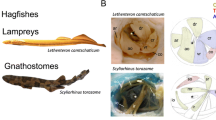Abstract
The rostral part of the notochord reveals many pecularities compared with the trunk mesoderm. Furthermore, its role in head formation and inductive processes in the head is not as well understood as the interaction of the trunk notochord with the spinal cord and somites. To interpret experimental and molecular biological examinations in the developing head region, exact knowledge about morphological features of the rostral notochord is fundamental. Here we show that the rostral notochord reveals variations that depend on species and individual. We describe morphological characteristics of the rostral (head) notochord in human embryos (Carnegie stages X—XIV), which are shown in semithin sections and three-dimensional graphic reconstructions. Special attention is paid to the relationship of the notochord with the prechordal mesoderm and the adenohypophysis. We propose that in the human the rostral notochordal tip terminates at Rathke’s pouch, whereas in the chick prechordal mesoderm is found inbetween the notochordal tip and the anlage of the adenohypophysis. The behaviour of the notochord at the end of the embryonic period proper and early fetal time is shown in sagittal histological sections of 16 to 49 mm CRL human embryos. Position and disintegration of the rostral notochord is also described in embryos of cat (8–25 mm), mouse (stage 21–24 according to Theiler) and chicken (stage 22–26 HH). A synopsis reveals the different course of the notochord within, at the inner or outer side of the basioccipital cartilage. The course of rostral notochord is determined by its attachment points at the hypophysis, the pharynx or the footplate of the brain. In all species, it has an undulating course. Its rostral tip is highly coiled, and fragments or splinters are found within the anlage of the dorsum sellae. Thus, we have reasons to believe that the adenohypophysis is a hindrance for the rostrad elongation of the notochord. Variable adhesions between notochord and pharyngeal epithelium are considered to be responsible for invaginations of the pharyngeal wall forming bursae pharyngeae. In contrast to other authors, we observed in the mouse that rostrally the notochord bends ventrad and penetrates the chondrocranium at the level of the later synchondrosis basisphenoidale to build a bursa pharyngea. Finally, partial duplications of two human notochords are described.
Similar content being viewed by others
Author information
Authors and Affiliations
Additional information
Accepted: 27 April 1999
Rights and permissions
About this article
Cite this article
Barteczko, K., Jacob, M. Comparative study of shape, course, and disintegration of the rostral notochord in some vertebrates, especially humans. Anat Embryol 200, 345–366 (1999). https://doi.org/10.1007/s004290050285
Issue Date:
DOI: https://doi.org/10.1007/s004290050285




